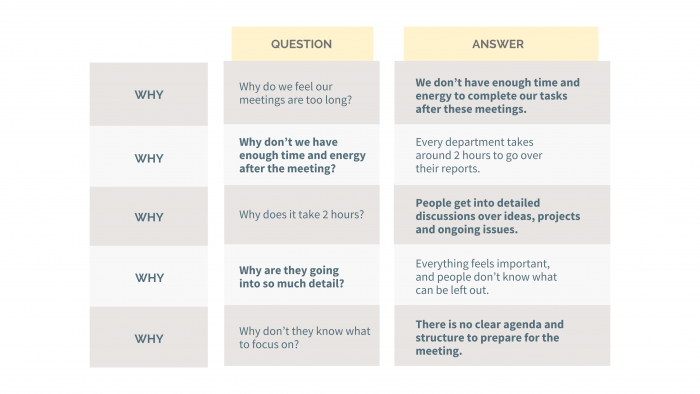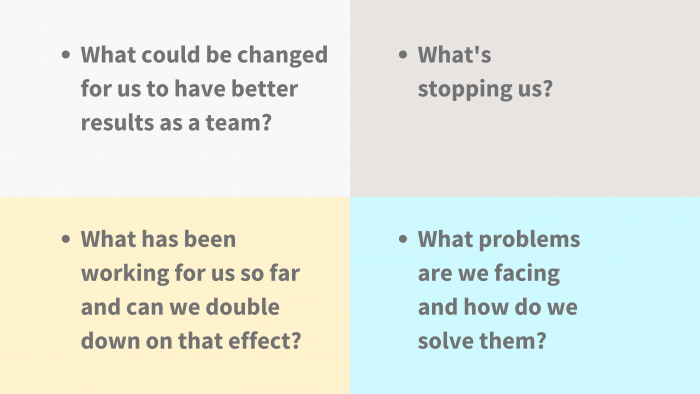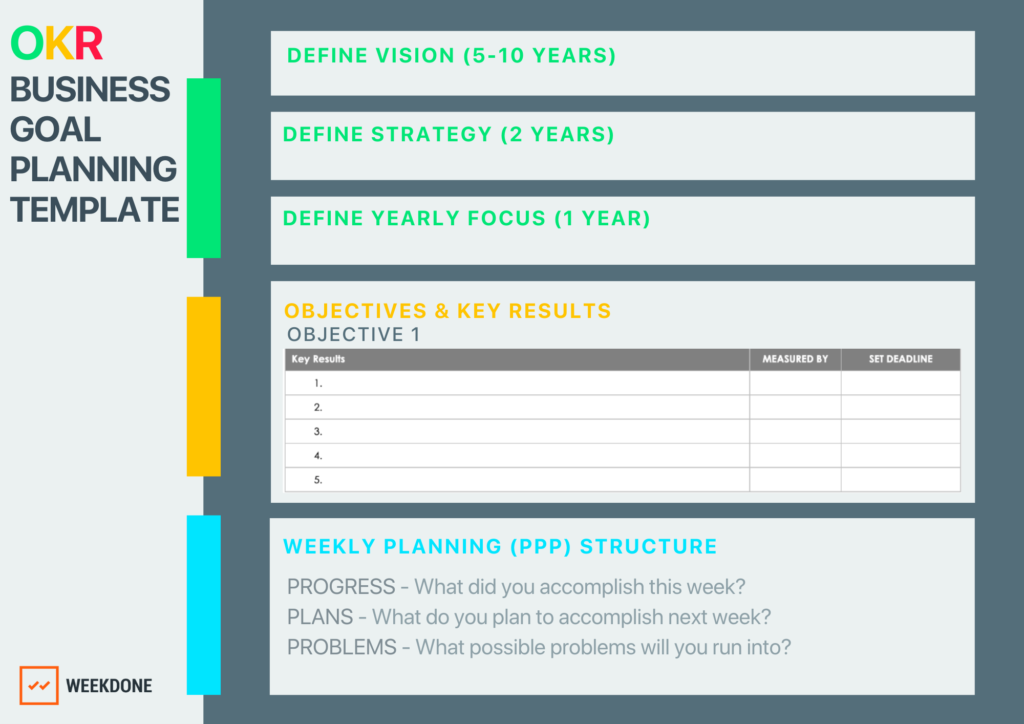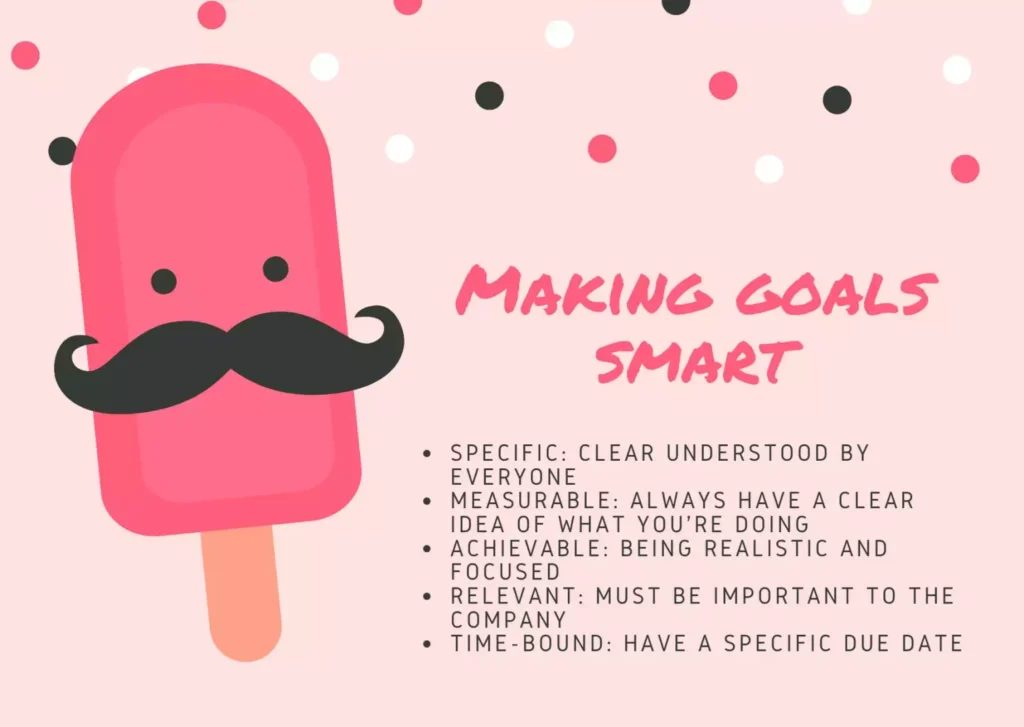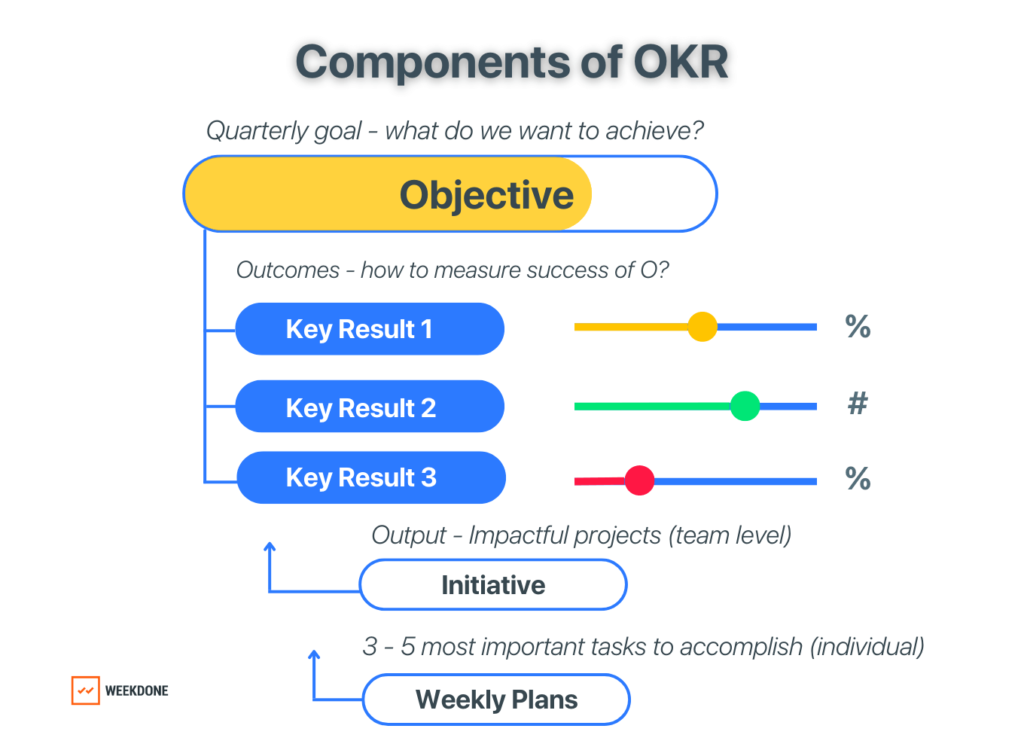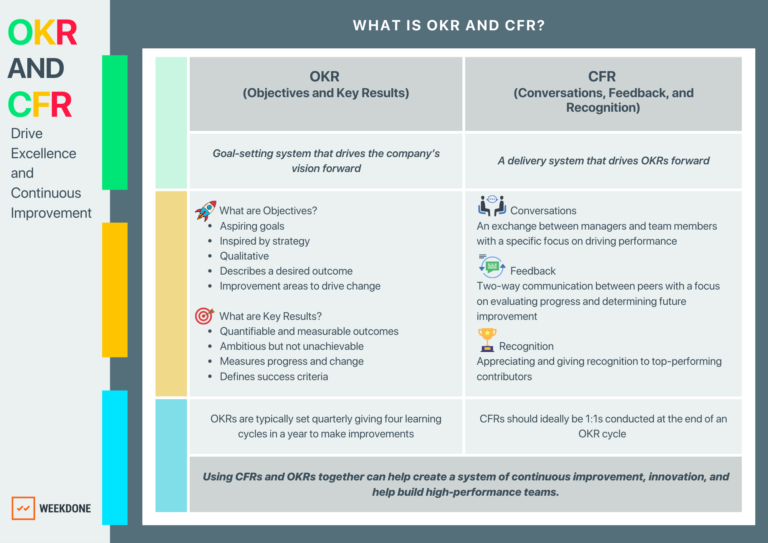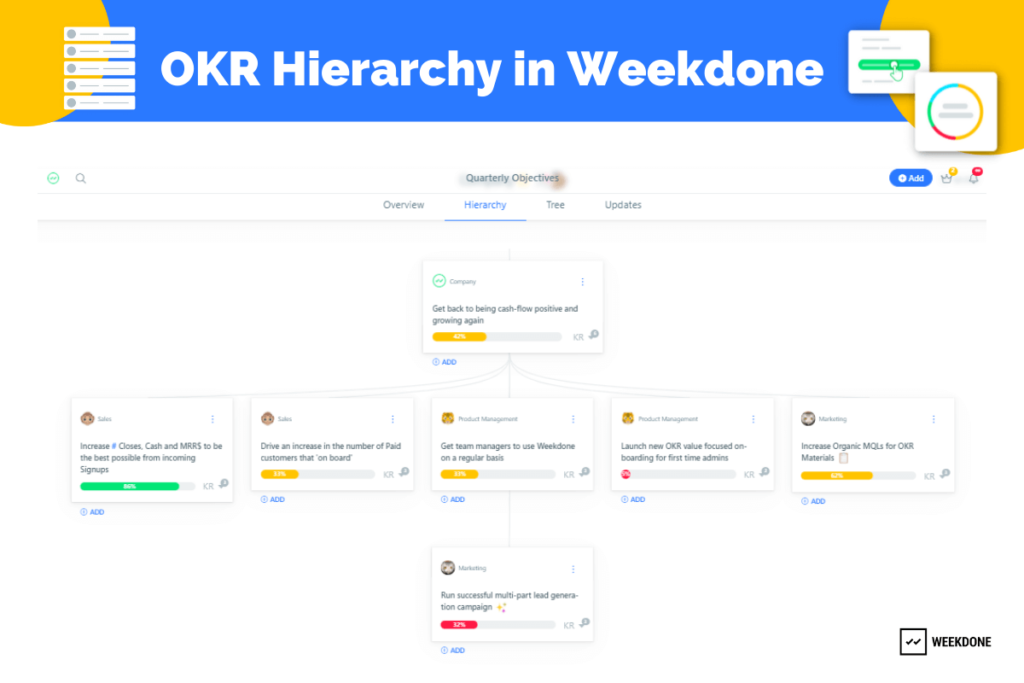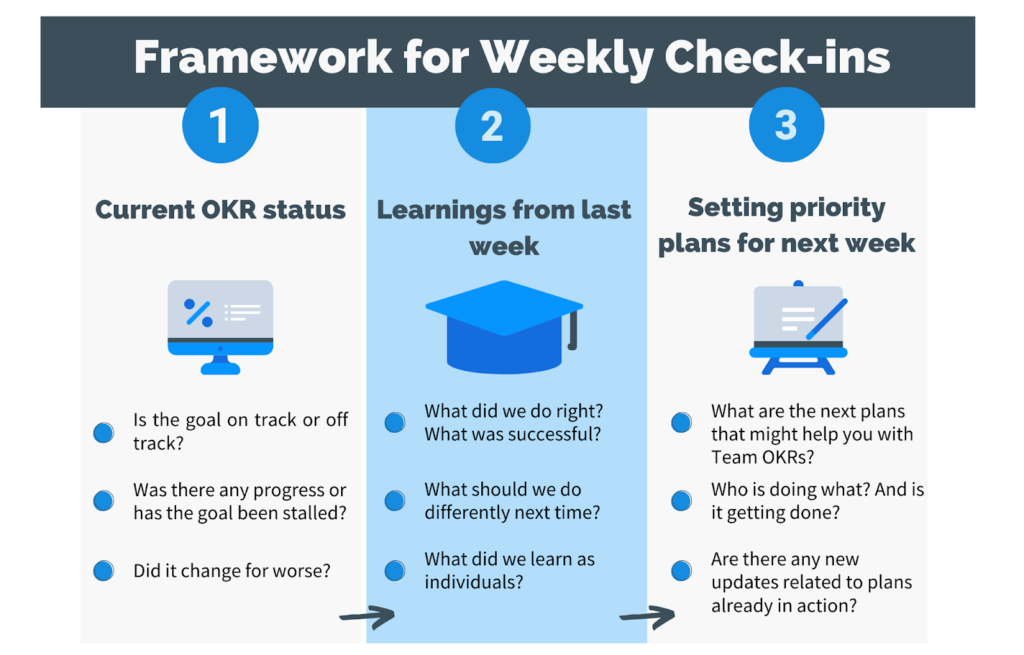Setting work goals can be more challenging than accomplishing them. Similar to setting personal development goals, where no two days are the same, goal-setting in a business environment that’s dynamic and unpredictable has become even more important to keep your team focused.
Writing actionable goals ensures that you, as a leader, have total control and visibility over your team’s progress. To learn how to write professional goals for work and make them actionable, keep in mind these tips:
- Identify the problem clearly – Stay on track by focusing on actual solutions instead of convenient fixes.
- Keep asking why – To truly find the source of the problem it is important to ask why
- Organize and be prepared before brainstorming meetings – Before attending meetings, structure the thought process of your team members and come prepared with ideas
- Focus on what matters –Think of problems that need to be solved right now and create a roadmap to working toward a solution
💡Here is a simple business goals template to articulate your work goals in one place
14 days free for unlimited users. Sign up today!
Where to begin? How to write achievable goals for work? How to make personal and professional development goals meaningful? How do you ensure that what you write is clear, achievable, inspirational, and easy to understand?
In this article, find the answers and discover 5 tips and work goals examples to achieve your objectives collaboratively and drive success.
6 Goal-Setting Tips and Examples of Work Goals
- Assess past goals and make them SMART + example goals
- Plan quarterly goals or OKRs + example goals
- Articulate and communicate goals clearly
- Make goal-setting a team exercise
- Enable cross-team collaboration and align goals
- Conduct check-ins regularly and set milestones
1. Assess Past Goals and Make them SMART
Use your previous examples of work goals as your starting point and guide for what needs to change and improve.
Whether you write SMART goals, or create OKRs, revisiting past examples of professional goals is a great way to set new ones. The advantage of knowing how that goal performed allows you to identify patterns, the way you approached it, and the reasons why it was successful or underperformed.
👉If you have written your goals, check how SMART they are. Take this SMART goal test.
Examples of Work Goals – Visualizing SMART Goals
When learning how to write professional goals for work, consider this example of a SMART goal. See how it was created to be specific, measurable, attainable, relevant, and time bound.
Goal example: Increase overall search engine traffic by 15% by the end of the quarter
- Specific: This goal specifically states that within the next 3 months, the objective is to increase search engine traffic by 15%.
- Measurable: It is measurable because it focuses on optimizing 5 high-performing content assets to boost 10 backlinks to that specific resource
- Achievable: It is made attainable by including stakeholders from other teams and including ideas related to improving copy
- Relevant: Organic traffic is accountable for the most visits to the website. This goal of increasing search engine traffic is relevant because it directly translates to own business success.
- Timely: Setting a time frame of 3 months makes this goal time bound and clearly states by when it must be completed
2. Plan Quarterly Goals or OKRs
Goals can exist in many different forms: daily, weekly, monthly, quarterly, and yearly. The question that arises is obvious: Which one do you choose, and why? The answer is quarterly and here is why.
Breaking down an annual goal into quarters gives you the time to execute your work goals and also see whether they yield results. Setting quarterly goals or OKRs (Objectives and Key Results) gives four learning cycles in the year, allowing teams to refine their goals every quarter for better outcomes.
To implement the OKR framework, consider the following aspects:
- Translate business strategy into the Company Objective and Key Results
- Create OKRs for different teams and ensure they are aligned with the Company’s Objective
- Add Initiatives to make progress toward achieving the Key Results (KRs)
- Create Weekly Plans to define individual efforts toward achieving the Team’s OKRs
Be mindful not to confuse goals with objectives. While goals are typically aspirational and set in the long term, objectives are specific and measurable action plans for teams to achieve the common goal.
The best practice is to use a bottom-up alignment technique, where the goals of different teams are aligned with the Company Objective. This can provide teams with ownership of the company’s Key Results and drive their efforts toward accomplishing the overall goal.
👉 To find examples of work goals and OKRs for different teams, watch this playlist, or if you want to learn how to write professional goals for work check out this OKR Best Practice video
14 days free for unlimited users. Sign up today, no CC required!
OKRs and Work Goals Examples
Leadership Goal Example
A great objective for leaders with a primary focus on growing revenue would be to achieve specific revenue growth in a certain period
Objective: Achieve $1 million in new revenue by Q4
- KR1: Devise strategies to increase the customer base by 50% by the end of Q4
- KR2: Develop an action plan with sales and marketing teams to increase high-intent leads by 50,000
- KR2: – Identify and optimize 3 processes to reduce costs by 30%
Marketing Team Goals Example
Objective: Refine messaging and conduct experiments in high-performing channels to generate better Marketing Qualified Leads (MQLs)
- KR1: Improve email marketing messages and workflow to increase MQLs from 80 to 150
- KR1: Create new campaigns to increase MQLs from AdWords from 90 to 120
- KR3: Identify 20 content assets to be created or optimized to increase MQLs from organic search from 50 to 70
Customer Support Team Example
Objective: Research customer behavior to improve customer satisfaction and reduce churn
- KR1: Conduct a satisfaction survey and obtain 1,000 responses
- KR2: Organize at least 60 phone interviews with high-value customers
- KR3: Identify 15 customers who recently churned and obtain responses through phone interviews and email messages
👉 To make it easier for you to get started, refer to 100+ OKR and work goals examples
If you have created your goals, set and implement them using OKR software. Watch and assess the progress you make toward achieving your goals.
3. Articulate and Communicate Goals Clearly
Another great example of setting work goals is being able to communicate them to the team in an effective way. Often, ideas and professional goals may make perfect sense in the mind but when it’s time to share them with the team, it could be incoherent and incomplete.
The professional skills to articulate goals clearly requires leaders to have exceptional communication skills. Before sharing professional goals with the team, make sure it answers the following questions:
- What? (The actual goal)
- Why? (You want to achieve this professional goal because …)
- Which? (Resources and skills that I need …)
- Who? (Who will do the work? The team)
- When? (Timeline/deadline for the goal)
- How? (Steps/plan to achieve it)
Answering these questions is a great way to ensure that the goals you have in mind are as ready as they can be in their draft version, before sharing them and improving them with your team.
4. Make Goal-Setting a Team Exercise
The difference between a good leader and a great leader is that the former sets work goals for their team whereas the latter sets goals with their team.
Team leaders that include team members in the process have a lot more to learn and a higher probability of succeeding.
The reasoning is simple. Open conversations with your team create a constant feedback loop, refining the outcome every time. This can strengthen the communication channel between you and your team and make them feel included and understand how their work contributes towards the overarching goals.
To address changing business conditions and shifting expectations, many leaders need to redefine how they manage and build high-performing teams. Combining several goal-setting frameworks such as OKRs and CFR (Conversations, Feedback, and Recognition), leaders and managers can drive higher performance by integrating these methodologies.
👉 Read more to find out how these goal-setting methodologies can drive greater performance
5. Enable Cross-Team Collaboration and Align Goals
While the modern workplace operates with independent and self-sufficient teams, aligning their goals can drive their efforts collaboratively. The challenge arises when teams work in silos and work only toward achieving their individual and team goals.
To bridge this gap and avoid overlapping goals, it is important for leaders to have collaboration skills to align goals. The OKR hierarchy view is one of the ways to get an overview to improve team collaboration and attain professional goal alignment. With an overview of the goals of all teams, leaders can see how they are interconnected and the progress made on professional goals in one platform.
The OKR hierarchy view shows how all Objectives of different teams align with the Company level objectives. With this view, team members can see how their work is connected with other stakeholders and teams, and it contributes to the bigger goals. Company-wide goal alignment is one of the primary factors to ensure success and that everyone is moving in the same direction.
6. Conduct Check-Ins Regularly and Set Milestones
In the process of achieving goals, it is important to set checkpoints and identify milestones. This can help to pause and assess progress, make adjustments, and realign the focus and efforts toward achieving the goal.
A great way of setting milestones is by conducting Weekly Check-ins. This simple and quick 15-20 minute meeting can prove to be invaluable in accomplishing the goals set at the beginning of the quarter. Improving team collaboration, team meetings are a great opportunity to resolve any problems that arise during the week, share learnings and outline priorities for the coming week.
Goal-setting is not a one-time exercise. It is a continuous process that requires consistent effort. Updating goals by assessing progress can ensure that you stay on track toward accomplishing them.
👉 To understand how you can track your OKRs by conducting Weekly Check-ins, Watch this video
Examples of Different Types of OKR Meetings & Check-Ins
Based on the company and team size, the number of meetings could vary. For small and medium-sized companies that have remote teams, it is recommended to have daily meetings. These meetings for small teams (2-10 people) could be short (not more than 10 to 20 minutes). Keep in mind that these sessions are about reporting tasks but more about discussing ongoing initiatives, new ideas, and assessing KPIs.
For cross-functional teams, two types of meetings can be conducted – execution (sprint planning) and OKR progress update meeting.
- In execution meetings, different teams can present what they are committed to delivering in the next 2 weeks. Serving as a great addition to project management, this meeting can give everyone a clear idea about the projects, plans, and initiatives of all teams.
- OKR progress meetings involve presenting the progress made toward achieving the Team’s OKRs. It can include discussions of how progress is made and the challenges that need to be addressed when progress is slow.
Strengthen Your Goal-Setting Process
Goal-setting is important for both personal and professional development. But setting work goals is not easy and requires a sustainable and robust framework that allows leaders and teams to track, manage and refine goals effectively.
Adopting the Objectives and Key Results (OKR) methodology provides an easier and more effective way to manage and align goals company-wide.
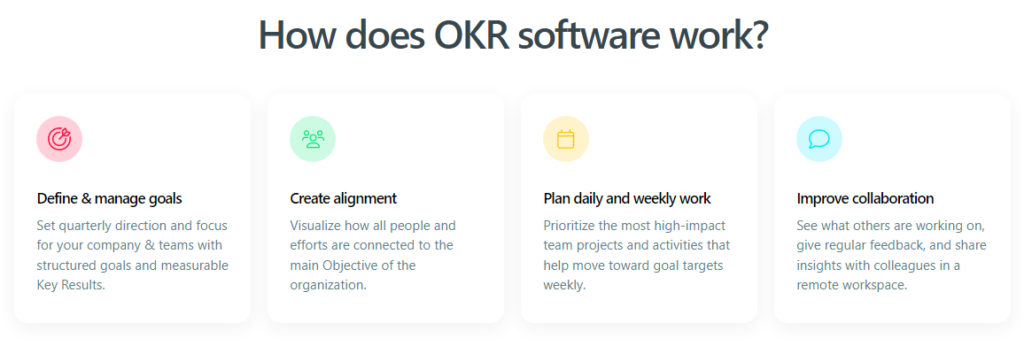
Using OKR software can help you set structured goals, align processes, and people across the organization. It provides a structured approach to set, view, track, assess, and manage all your goals in one platform.
In an environment where change is constant, a dedicated OKR software can help you stay on track and can provide the agility needed to make improvements required to keep up with the speed of business.
